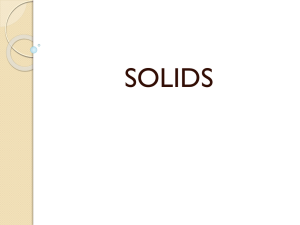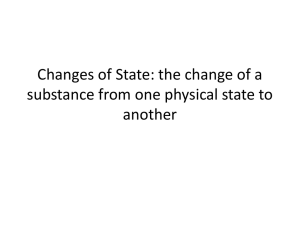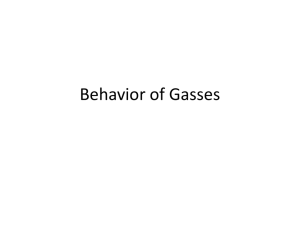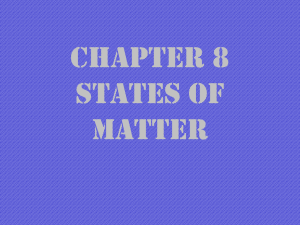Chapter 3 Solids, Liquids and Gases
advertisement
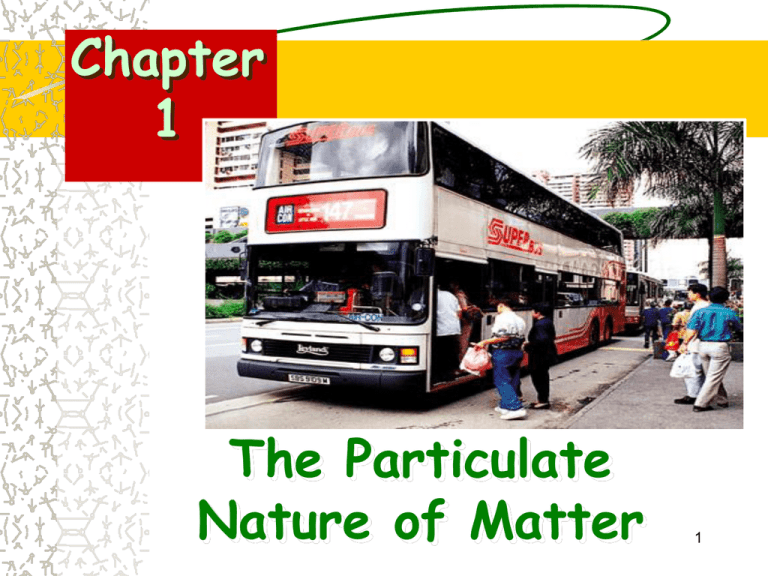
Chapter 1 The Particulate Nature of Matter 1 You will learn about: contents •Properties of matter in the solid, liquid and gaseous states •The Kinetic Particle Theory •The inter-conversion of the states of matter 2 states of matter • All substances are made of matter. •The three states of matter are solid, liquid and gas gas solid liquid water exist as three states of matter 3 Properties of matter in solid, liquid and gaseous states Main Features of Solids, Liquids and Gases Solids Liquids Gases Shape Fixed No fixed shape; take the shape of container No fixed shape; expand to take the shape of container Hardness Hard and is usually made of crystals Not hard and can flow easily Not hard. Can flow along a pipeline and diffuse easily Density High density medium density Low density Compression No No Easily compressed Fixed No fixed volume; expand to fill the container Volume Fixed 4 The Kinetic Particle Theory •Scientists have gathered evidence from diffusion experiments, changes in volume and changes in states and hypothesized that matter is made up of small particles. •The ancient Greeks were the first to suggest that everything is made up from particles. Thus, scientists came up with the Kinetic Particle Theory. The Kinetic Particle Theory states that all matter is made up of tiny particles, and these particles of matter are always in constant random motion. 5 particles of matter Property Solid Liquid Gas Arrangement and Packing between particles Particles are in orderly arrangement and are packed very closely together. Particles are not in orderly arrangement and is closely packed together. Particles are not in orderly arrangement and are very far apart from one another. Motion of particles Particles vibrate about a fixed position Particles are free to move around the liquid and slide over each other. Particles are very far apart from each other. Forces of attraction between particles Very strong forces of attraction between particles Strong forces of attraction between particles Very weak forces of attraction between particles Diagrammatic representation of particles in each state 6 particles of matter QuickTime™ and a Cinepak decompressor are needed to see this picture. 7 Inter-conversion of states of matter melting •When a solid is heated, particles gain kinetic energy and vibrate faster. •At a certain temperature, particles would have gained enough energy to overcome the attractive forces holding the particles of solid together in fixed positions. •Melting occurs. Particles now are able to move around the liquid and slide over one another. Why is a water bath used? temperature Prevent direct heating of combustible substances stearic acid experiment to find the melting point of stearic acid water at 100ºC 8 HEAT Inter-conversion of states of matter QuickTime™ and a Cinepak decompressor are needed to see this picture. 9 changes of state melting Graph of temperature vs time plotted to depict melting process temperature (ºC) melting starts melting point (69°C) melting completes SOLID + LIQUID SOLID temperature remains constant. Why? LIQUID Heat energy absorbed by the particles is used to overcome the forces of attraction holding the particles together in their fixed positions. time from start (min) 10 changes of state freezing • When a liquid is cooled, particles lose kinetic energy and move slower and come closer together. •At a certain temperature, particles no longer have enough energy to move around the liquid. •Freezing occurs. Liquid changes into a solid and particles can only vibrate in their fixed and orderly positions. Heat energy is given out during freezing. •Freezing and melting points are the same for a pure substance. 11 changes of state freezing Graph plotted to depict freezing Heat loss due to cooling is exactly balanced by the heat energy liberated as the particles attract one another to form a solid. temperature (ºC) LIQUID freezing point (=melting point) for pure substances temperature remains constant. Why? SOLID LIQUID + SOLID freezing starts freezing completes time from start (min) 12 changes of state boiling • When a liquid is heated, the particles gain kinetic energy and move faster. •At a certain temperature, particles throughout the liquid gain enough energy to overcome the forces of attraction holding them together in the liquid. •Boiling occurs. Liquid changes into a gas. Particles are now able to move freely and randomly around at great speeds. thermometer water out condenser liquid trichloroethane experiment to find the boiling point of 1,1,1-trichloroethane HEAT boiling stones water in liquid trichloroethane 13 changes of state boiling Graph plotted to depict boiling temperature (ºC) The temperature remains constant during boiling because the heat energy is absorbed by the particles of liquid to overcome the forces of attraction holding them together. boiling starts at point A 74ºC A B liquid is boiling between points A and B 0 Boiling occurs when the vapour pressure of the substance equals to the ambient pressure. time from start (min) A pure substance has a fixed boiling point at a fixed pressure. Boiling point increases when pressure increases (i.e. pressure cooker) and boiling point decreases when pressure decreases. (on mountain top) 14 changes of state evaporation • occurs when liquids turn into gases without boiling. •Evaporation occurs because some particles near the surface of the liquid have enough energy to escape as a gas. •Liquids which vaporize quickly at low temperatures are called volatile liquids. •Differences between Boiling and Evaporation: Boiling Evaporation occurs only at boiling point occurs at temperatures below boiling point takes place throughout the liquid takes place at the surface of the liquid very fast process very slow process 15 changes of state condensation • When a gas is cooled, particles lose kinetic energy and move more slowly. The particles come closer to one another. •At a certain temperature, the particles no longer have enough energy to move about randomly at great speed. •Condensation takes place. The gas is changed into a liquid. Heat energy is given out during condensation. sublimation • Change of state from solid to gas without melting. •Sublimation occurs because some particles have enough energy to break off from the solid and escape as a gas. •Examples include iodine, ammonium chloride and solid carbon dioxide (dry ice) 16 changes of state sublimation QuickTime™ and a Cinepak decompressor are needed to see this picture. 17 energy fixed shape has particles can only vibrate has least solid melting particles freezing because shape of container has because are close together in disorderly arrangement in particles can mix together by liquid boiling particles can move so liquids flow condensation particles can mix together by diffusion gas sublimation can be energy compress no shape 18

